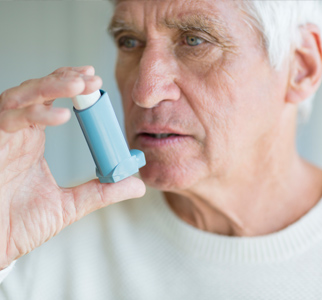Q&A: When You’re Diagnosed with Both Asthma and COPD
When you’re diagnosed with asthma or chronic obstructive pulmonary disease (COPD), it can be difficult to breathe. But did you know that about 15% to 55% of adults with one of these lung diseases actually qualify for a dual diagnosis?

This dual diagnosis is called asthma-COPD overlap syndrome (ACOS). People at risk for ACOS are typically those with asthma who smoke, but healthcare providers also see cases in those who don’t use tobacco. The right diagnosis is important with lung conditions, and education is key to understanding treatment options. To learn more about ACOS, read the answers to some common questions below.
Q: What’s the difference between asthma and COPD?
Asthma occurs frequently in people with a family history of the disease and often begins in childhood. Symptoms include shortness of breath, wheezing, coughing, and chest tightness, and these symptoms flare up during an asthma attack. At other times, symptoms may fade or become minimal.
COPD is different and usually strikes later in life. Most people diagnosed with COPD either used to smoke, or still do. Some symptoms—such as chest tightness and coughing—are similar to asthma. Other symptoms, such as mucus production, are distinct to COPD. Unlike asthma, symptoms rarely ever fade completely.
Q: What does it mean if I’m diagnosed with both conditions?
ACOS means you have some symptoms of asthma and some of COPD. As with COPD, you may often have trouble breathing. But like asthma, you may have flare-ups or attacks more frequently than someone with COPD alone.
Q: What should I do if I have respiratory symptoms?
Talk with your healthcare provider. He or she will likely recommend a spirometry test, which measures how much air you can breathe out (and how quickly). You may also need to get a chest X-ray so your provider can gain a better understanding of your symptoms or condition.
Q: How is ACOS treated?
Your provider can begin treatment if you have COPD or asthma alone. But if you have ACOS, you may want to see a pulmonologist—a specialist in lung health. People with ACOS often experience more severe symptoms than those with a single lung disease, but working with a specialist can help you feel better. Treatment for ACOS usually includes medicine.
Q: How can I improve my lung health on my own?
No matter which lung condition you have, working closely with your healthcare team can control its effects on your everyday life. But there are other steps you can take as well. For instance, if you smoke, it’s never too late to quit. Make sure that you’re current with all vaccinations, especially the pneumococcal and annual flu vaccine. These viruses can be very harmful to people with a lung disease. In addition, consider asking your provider about pulmonary rehabilitation if you have consistent breathing problems. This type of rehabilitation focuses on managing symptoms, exercising, and eating a nutritious diet.